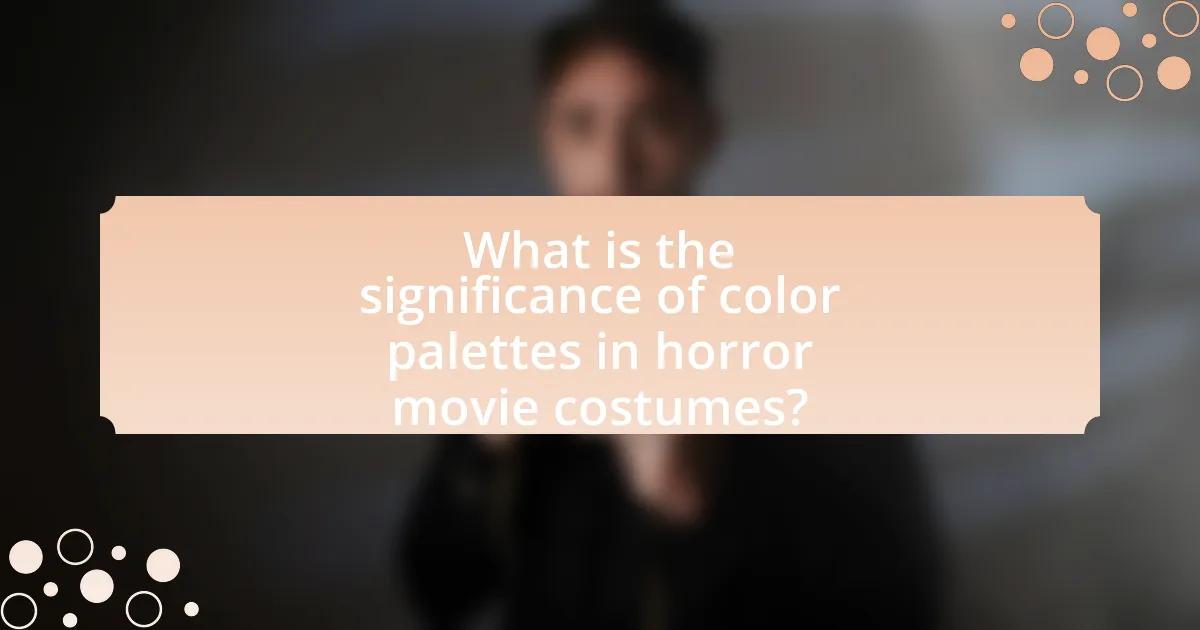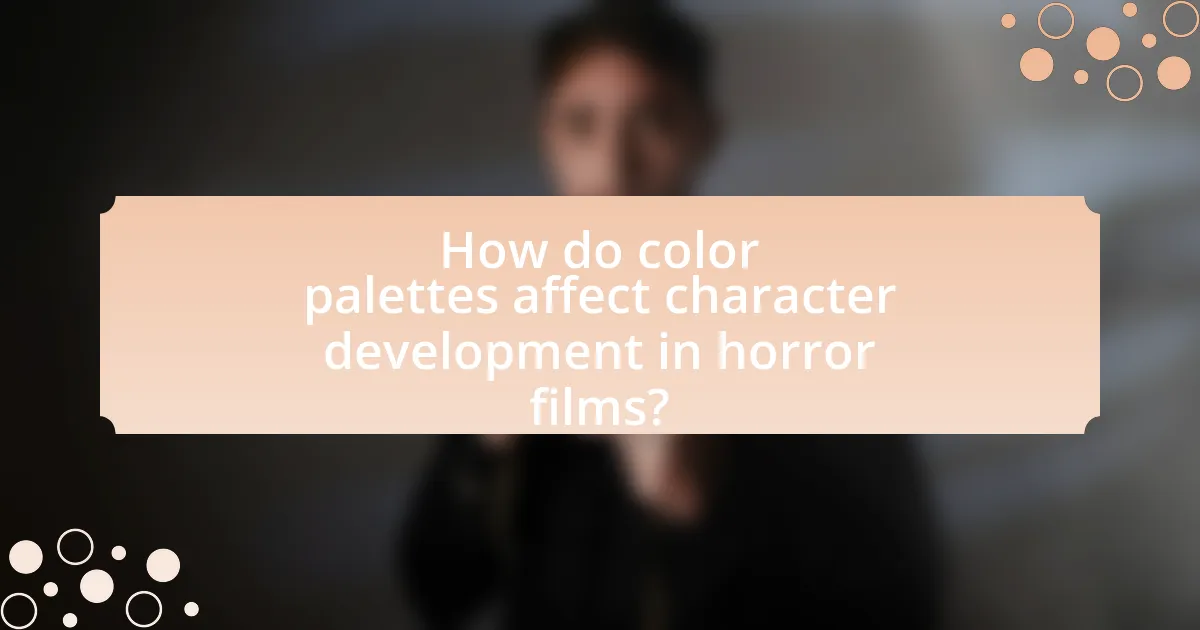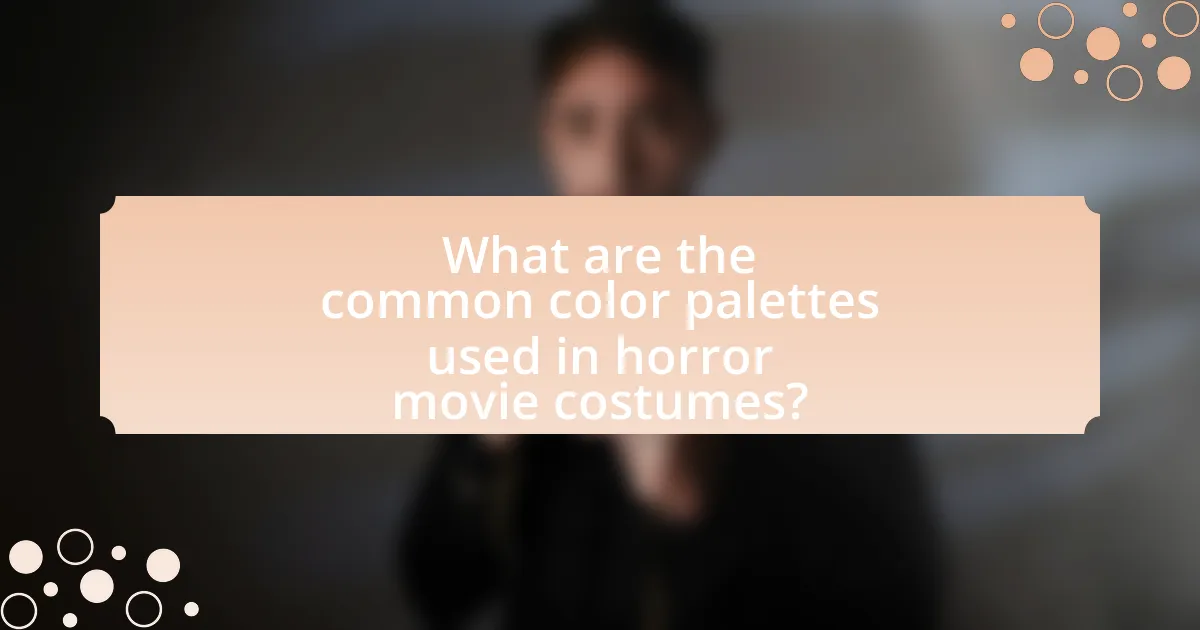The article examines the significance of color palettes in horror movie costumes, highlighting their role in evoking emotions and enhancing the psychological impact of films. It discusses how specific colors, such as black and red, symbolize fear and danger, while contrasting colors create tension and highlight character traits. The article also explores the influence of color on audience perception, character development, and storytelling, emphasizing the strategic selection of colors by filmmakers to reinforce themes and emotional responses in various horror sub-genres. Additionally, it provides practical tips for filmmakers on choosing effective color palettes to enhance the horror aesthetic.

What is the significance of color palettes in horror movie costumes?
Color palettes in horror movie costumes are significant because they evoke specific emotions and enhance the psychological impact of the film. For instance, dark colors like black and red often symbolize fear, danger, and violence, while contrasting colors can create a sense of unease or highlight certain characters. Research indicates that color can influence viewer perception and emotional response; for example, a study published in the Journal of Experimental Psychology found that colors can affect mood and feelings of anxiety. Therefore, the strategic use of color palettes in horror costumes is essential for establishing atmosphere and deepening audience engagement with the narrative.
How do color palettes influence the overall atmosphere of horror films?
Color palettes significantly influence the overall atmosphere of horror films by evoking specific emotional responses and enhancing the narrative’s tension. Dark and muted colors, such as blacks, grays, and deep reds, create a sense of dread and foreboding, while contrasting colors can highlight moments of shock or violence. For instance, the use of desaturated colors in films like “The Witch” amplifies feelings of isolation and fear, while vibrant colors in “Suspiria” heighten the surreal and unsettling nature of the story. Research indicates that color can affect mood and perception, with studies showing that certain hues can trigger anxiety or discomfort, thus reinforcing the horror genre’s themes.
What emotions do different colors evoke in viewers?
Different colors evoke specific emotions in viewers, influencing their psychological responses. For instance, red often evokes feelings of passion, anger, or urgency, while blue tends to elicit calmness and tranquility. Yellow is associated with happiness and energy, whereas green can represent nature and balance, but also envy. Black typically conveys fear, mystery, or death, which is particularly relevant in horror contexts. Research by the Institute for Color Research indicates that people make a subconscious judgment about a person, environment, or product within 90 seconds of initial viewing, and that 62-90% of this assessment is based on color alone. This underscores the significant role colors play in shaping emotional responses, especially in horror movie costumes where color palettes are strategically chosen to enhance fear and tension.
How do color choices enhance the storytelling in horror movies?
Color choices significantly enhance storytelling in horror movies by evoking specific emotions and creating atmospheric tension. For instance, the use of dark colors like black and deep red often symbolizes fear, danger, and blood, which can heighten the viewer’s sense of dread. Research indicates that colors can influence psychological responses; for example, a study published in the Journal of Experimental Psychology found that red can increase arousal and anxiety levels, making it effective in horror contexts. Additionally, contrasting colors can be used to signify the presence of good versus evil, further enriching the narrative. Thus, strategic color palettes in horror films not only support visual storytelling but also manipulate audience emotions to deepen engagement with the plot.
Why are specific colors associated with horror genres?
Specific colors are associated with horror genres primarily due to their psychological impact and cultural symbolism. For instance, red often represents blood, danger, and violence, evoking feelings of fear and urgency, while black symbolizes death, the unknown, and evil, creating a sense of dread. Research in color psychology indicates that these colors can trigger emotional responses that enhance the horror experience, making them effective tools in visual storytelling. Historical usage in horror films, such as the iconic use of red in “Psycho” and black in “The Exorcist,” reinforces these associations, demonstrating how color choices contribute to the overall atmosphere and emotional resonance of horror narratives.
What cultural meanings do colors hold in horror contexts?
Colors in horror contexts often symbolize fear, death, and the supernatural. For instance, black represents death and the unknown, while red signifies blood, violence, and danger. These associations are culturally ingrained; in many societies, black is worn at funerals, reinforcing its connection to mortality. Red’s use in horror films often heightens tension and evokes visceral reactions, as seen in classic horror movies where blood is a central theme. Additionally, green can symbolize decay or the unnatural, often used to depict zombies or toxic environments. These color meanings are utilized strategically in horror movie costumes to evoke specific emotional responses and enhance the narrative’s impact.
How do filmmakers use color symbolism to convey fear?
Filmmakers use color symbolism to convey fear primarily through the strategic use of dark and muted colors, such as blacks, grays, and deep reds. These colors evoke feelings of dread and anxiety, as they are often associated with death, violence, and the unknown. For instance, the use of red can symbolize blood and danger, heightening the emotional response of the audience. Research indicates that colors like blue and green can also create a sense of unease when used in specific contexts, as they may suggest decay or illness. The psychological impact of these colors is supported by studies in color theory, which show that certain hues can trigger instinctual reactions related to fear and survival.

How do color palettes affect character development in horror films?
Color palettes significantly influence character development in horror films by establishing emotional tone and psychological depth. For instance, the use of dark colors like black and red often symbolizes fear, danger, or evil, shaping audience perceptions of characters as either antagonists or victims. Research indicates that colors can evoke specific emotional responses; for example, studies show that red can increase feelings of aggression and urgency, while blue may evoke calmness or sadness. This strategic use of color not only enhances the narrative but also deepens the audience’s connection to the characters, making their experiences more visceral and impactful.
What role do colors play in defining a character’s personality?
Colors play a crucial role in defining a character’s personality by conveying emotions, traits, and psychological states. For instance, red often symbolizes passion or aggression, while blue can represent calmness or sadness. Research in color psychology indicates that colors can influence perceptions and behaviors; for example, a study by Andrew Elliot and Markus Maier published in the journal “Emotion” found that red can enhance feelings of power and dominance. In horror movies, the strategic use of color palettes helps to establish character identities and evoke specific emotional responses from the audience, reinforcing the narrative and thematic elements of the film.
How can color choices indicate a character’s moral alignment?
Color choices can indicate a character’s moral alignment by symbolically representing traits associated with specific colors. For instance, dark colors like black often signify evil or malevolence, while lighter colors such as white can represent purity or goodness. This association is supported by psychological studies, such as those by Andrew Elliot and Daniela Maier, which demonstrate that colors evoke emotional responses and can influence perceptions of character traits. In horror movies, a character dressed in red may suggest aggression or danger, while a character in green might imply jealousy or decay, reinforcing their moral stance within the narrative.
What examples illustrate the impact of color on character perception?
Color significantly influences character perception in horror movies, as evidenced by the use of specific color palettes to evoke emotions and reactions. For instance, the color red often symbolizes danger or violence, making characters dressed in red appear more threatening or aggressive, as seen in films like “Carrie.” Conversely, the color white can evoke innocence or purity, which can create a stark contrast when a character with a white costume engages in horrific acts, exemplified by the character of the Bride in “Bride of Chucky.” Additionally, dark colors like black are frequently associated with evil or malevolence, enhancing the perception of characters like Freddy Krueger in “A Nightmare on Elm Street.” These examples illustrate how color choices in costumes directly shape audience perceptions and emotional responses to characters in horror films.
How do costume designers select color palettes for horror films?
Costume designers select color palettes for horror films by analyzing psychological effects of colors and their cultural associations. They often choose dark, muted tones like blacks, reds, and greens to evoke feelings of fear, unease, and tension, aligning with the genre’s themes. Research indicates that colors such as red can symbolize danger and aggression, while black often represents death and the unknown, making them effective choices in horror contexts. Additionally, designers consider the narrative and character arcs, ensuring that the color palette enhances the story’s emotional impact and visual storytelling.
What factors influence the choice of colors in costume design?
The choice of colors in costume design is influenced by psychological effects, character representation, and thematic elements. Psychological effects dictate how colors evoke emotions; for instance, red can signify danger or passion, while blue may convey calmness. Character representation relies on colors to reflect traits or arcs; a villain might wear darker shades to symbolize malevolence, whereas a hero may don brighter hues to represent hope. Thematic elements tie colors to the overall narrative; in horror films, muted or contrasting colors can enhance tension and fear, as seen in the use of dark palettes to create a sense of dread.
How do historical and cultural contexts shape color selections?
Historical and cultural contexts significantly influence color selections by dictating the meanings and associations attached to specific colors. For instance, in Western cultures, black is often associated with mourning and death, which aligns with its frequent use in horror movie costumes to evoke fear and dread. Conversely, in some Eastern cultures, white symbolizes purity and is used in rituals, affecting how colors are perceived and utilized in various contexts, including film. Additionally, historical events, such as the Gothic Revival in the 19th century, led to a resurgence of dark, moody color palettes in art and fashion, which filmmakers often draw upon to create atmospheric tension in horror genres. These contextual factors shape not only the aesthetic choices but also the emotional responses elicited from audiences.

What are the common color palettes used in horror movie costumes?
Common color palettes used in horror movie costumes include dark shades such as black, deep red, and muted greens, often combined with stark contrasts like white or gray. These colors evoke feelings of fear, dread, and unease, which are essential in creating a horror atmosphere. For instance, black symbolizes death and the unknown, while red often represents blood and violence. The use of these palettes is supported by psychological studies indicating that colors can significantly influence emotions and perceptions, making them effective tools in horror film design.
What are the typical colors found in horror costumes?
Typical colors found in horror costumes include black, red, white, and green. Black is often used to evoke fear and mystery, while red symbolizes blood and danger. White can represent the supernatural or ghostly elements, and green is frequently associated with decay or illness. These colors are strategically chosen to enhance the emotional impact of horror themes, as evidenced by their consistent use in classic horror films and literature, where they contribute to the overall atmosphere and character portrayal.
How do dark colors contribute to the horror aesthetic?
Dark colors significantly contribute to the horror aesthetic by evoking feelings of fear, unease, and the unknown. These colors, such as black, deep red, and dark blue, create a stark contrast with lighter shades, enhancing the sense of foreboding and tension in visual storytelling. Research indicates that dark colors are often associated with negative emotions and themes, reinforcing the psychological impact of horror elements. For instance, a study published in the Journal of Experimental Psychology found that darker hues can trigger instinctual responses linked to danger and threat, making them effective in horror film costumes to amplify the overall atmosphere of dread.
What role do contrasting colors play in creating tension?
Contrasting colors play a crucial role in creating tension by visually stimulating the viewer and evoking emotional responses. In horror movies, the use of stark color contrasts, such as black and white or red and green, heightens the sense of unease and fear, making scenes more impactful. Research indicates that contrasting colors can trigger psychological reactions; for instance, studies show that high contrast can increase anxiety levels in viewers, as it draws attention and creates a sense of urgency. This technique is often employed in horror film costumes to amplify the emotional stakes and enhance the overall atmosphere of dread.
How do color palettes vary across different horror sub-genres?
Color palettes in horror sub-genres vary significantly, reflecting the themes and emotions each sub-genre aims to evoke. For instance, psychological horror often utilizes muted, desaturated colors to create a sense of unease and tension, while slasher films frequently employ bright reds and stark contrasts to emphasize violence and bloodshed. Supernatural horror tends to favor dark blues and greens, enhancing the eerie atmosphere associated with the unknown. Additionally, campy horror may incorporate vibrant, exaggerated colors to evoke a sense of irony or humor. These color choices are not arbitrary; they are strategically employed to enhance the narrative and emotional impact, as evidenced by studies on color psychology in film, which demonstrate that specific colors can elicit distinct emotional responses from audiences.
What color trends are prevalent in psychological horror versus slasher films?
Psychological horror films predominantly utilize muted, desaturated colors such as grays, blues, and earth tones to evoke feelings of unease and tension, while slasher films often employ bright reds and stark contrasts, particularly with blood, to create shock and emphasize violence. The use of these color palettes in psychological horror aims to reflect the internal struggles and fears of characters, enhancing the atmosphere of dread, as seen in films like “The Shining,” which uses a cold color scheme to amplify psychological tension. In contrast, slasher films like “Halloween” leverage vibrant colors to heighten the visceral impact of the violence, drawing attention to the gore and creating a more sensational experience. This distinction in color trends underscores the differing emotional responses elicited by each genre, with psychological horror focusing on subtlety and atmosphere, while slasher films prioritize shock and visual stimulation.
How do color choices reflect the themes of supernatural horror?
Color choices in supernatural horror reflect themes of fear, the unknown, and the uncanny through the use of dark, muted, and contrasting palettes. Dark colors like black and deep red evoke feelings of dread and danger, while muted tones can create an unsettling atmosphere that enhances the sense of isolation and vulnerability. For example, films such as “The Witch” utilize a desaturated color palette to emphasize the bleakness of the setting and the characters’ psychological turmoil, reinforcing the horror elements. Additionally, contrasting colors, like the use of bright whites against dark backgrounds, can symbolize the clash between good and evil, heightening the tension inherent in supernatural narratives. This strategic use of color not only sets the mood but also visually communicates the emotional states of characters and the overarching themes of the genre.
What practical tips can filmmakers use when choosing color palettes for horror costumes?
Filmmakers can enhance the impact of horror costumes by selecting color palettes that evoke fear and tension. Utilizing dark colors like black, deep red, and muted greens can create a sense of dread, as these shades are often associated with death and decay. Additionally, contrasting colors, such as bright whites or vivid reds against darker tones, can draw attention to specific elements of the costume, heightening the emotional response from the audience. Research indicates that color psychology plays a significant role in viewer perception; for instance, studies show that red can increase feelings of aggression and urgency, making it effective in horror contexts. By strategically combining these colors, filmmakers can craft visually striking costumes that reinforce the horror narrative and elicit strong emotional reactions.